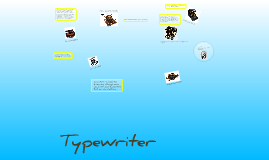Typewriter
Transcript: The Typewriter A Timeline of this invention Brief Background A Typewriter is a machine where you can type what you would instead handwrite. It is quicker, and better. Many people attempted to invent this machine. In fact,it took 52 attempts to invent one that was commercially successful. Some were failures. Others, not. 1714 Henry Mill got a patent machine similar to a typewriter. He described it as "A machine for transcribing letters" 1808 1829 William Austin Burt built a version of the typewriter that did in fact work. It chose a capital or lower case letter by turning a dial. It was not popular though, because it was ahead of its time. And also, it was quicker to handwrite then to type on what he called the "Typeowriter" 1865 The Hansen writing ball may be regaurded as 'The Holy Grail of typewriters. It is a machine that worked quite well and was popular. Rasmus Hans Malling Johan Hansen created the Hansen writing ball because he worked as a teacher and director of an institute for the deaf and dumb in Copenhagen. He wanted his pupils to speak with their fingers and this led him to the making of this glorious typewriter. There was a telegraphic model, a cryptographic model and a model for the blind. Parts of the Hansen Ball 52 buttons semi sphere on top. perfectly placed letters 3 models; telegraphic model cryptographic model model for the blind 1868 Christopher Latham Soles invents the first practical typewriter. It was commerically succesful, and would later become very popular. Carlos Glidden and Samuel Soule helped him invent this typewriter and it is truley a fascinating story. Sholes Glidden and Soule all built the machine, but Sholes patented the idea, and stuck through throughout the whole process. He patented the idea to build something that numbered things such as tickets. Glidden suggested that he make it type words and letters as well. And so the journey began. History of Sholes: Born: February 14th, 1819 in Moorsburg, PA. Died: February 17th,1890 in Milwaukee, WS Although Sholes worked in the Wisconsin State Senate and the Wisconsin State Assembly, he was not a member of the Mason Club like Mr. Shasteen... A mechanical engineer, and worked as an apprentice to a printer. He became a newspaper publisher of the Kenosha Telegraph. Sholes, Glidden, and Soule build their first machine. It has many problems such as jamming and inefficiency. But it works, when it's not breaking... James Densmore in September 1867 bought 25% interest for $600 for the machine, without even seeing it. He had heard what the three were trying to do and was very interested as he heard they had an early model. Densmore first saw the machine in March 1868, and was unimpressed and not satisfied. He thought it was clumsy and unpractical although it was a model with a full alphabet, numbers, and rudimentary punctuation. Densmore declared it "good for nothing except to show that its underlying principles were sound". This early model held the paper horizontal for example, and although Densmore was not happy, he rented a building in Chicago and started production. They made 15 models before they ran out of money and were forced to restart. 1869 Sholes worked hard and produced a better version and sent prototypes to professionals such as stenographers. They sent a machine to James Clephane, a stenographer and his heavy use destroyed several of these typewriters. But his critcal feedback led Sholes to create 25 - 30 new changes in a completely different machine similar to the others. Sholes improved it. 1870 Densmore traveled to New York to demonstrate the machine to Western Union, which was looking for a method to record telegrams. Western Union ordered several machines, but declined to purchase the rights, as it believed a superior device could be developed for less than Densmore's asking price of $50,000. 1871 Densmore began to manufacture the machine in summer of 1871. During this time, the machine was revised to improve durability and the paten was redesigned after feedback from Western Union, which wanted the ability to print on a continuous roll, indicated that clipping paper to the platen was impractical. 1872 Sholes ends up selling his portion for $12,000. A wheelwright was bought in order to manufacture machines and several employees were hired. Although the machines worked well, they were expensive and not selling too well. 1873 Following a demonstration at Remington's offices in New York, the company contracted on March 1, 1873, to manufacture 1,000 machines, with the option to produce an additional 24,000 1874 By December 1874, only 400 typewriters had been sold, due in part to their high price and poor reliability. The machine was being sold for about $125 which adjusted for inflation for today would be about $2380.94 Mark Twain would buy one of these typewriters (random fact) 1878 An improved model, the Remington No. 2, was also introduced in 1878. The new machine was able to type upper and lowercase characters,

















